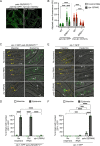A pals-25 gain-of-function allele triggers systemic resistance against natural pathogens of C. elegans
- PMID: 36191002
- PMCID: PMC9560605
- DOI: 10.1371/journal.pgen.1010314
A pals-25 gain-of-function allele triggers systemic resistance against natural pathogens of C. elegans
Abstract
Regulation of immunity throughout an organism is critical for host defense. Previous studies in the nematode Caenorhabditis elegans have described an "ON/OFF" immune switch comprised of the antagonistic paralogs PALS-25 and PALS-22, which regulate resistance against intestinal and epidermal pathogens. Here, we identify and characterize a PALS-25 gain-of-function mutant protein with a premature stop (Q293*), which we find is freed from physical repression by its negative regulator, the PALS-22 protein. PALS-25(Q293*) activates two related gene expression programs, the Oomycete Recognition Response (ORR) against natural pathogens of the epidermis, and the Intracellular Pathogen Response (IPR) against natural intracellular pathogens of the intestine. A subset of ORR/IPR genes is upregulated in pals-25(Q293*) mutants, and they are resistant to oomycete infection in the epidermis, and microsporidia and virus infection in the intestine, but without compromising growth. Surprisingly, we find that activation of PALS-25 seems to primarily stimulate the downstream bZIP transcription factor ZIP-1 in the epidermis, with upregulation of gene expression in both the epidermis and in the intestine. Interestingly, we find that PALS-22/25-regulated epidermal-to-intestinal signaling promotes resistance to the N. parisii intestinal pathogen, demonstrating cross-tissue protective immune induction from one epithelial tissue to another in C. elegans.
Conflict of interest statement
The authors have declared that no competing interests exist.
Figures







Similar articles
-
Multiple pals gene modules control a balance between immunity and development in Caenorhabditis elegans.bioRxiv [Preprint]. 2023 Jan 18:2023.01.15.524171. doi: 10.1101/2023.01.15.524171. bioRxiv. 2023. Update in: PLoS Pathog. 2023 Jul 18;19(7):e1011120. doi: 10.1371/journal.ppat.1011120. PMID: 36711775 Free PMC article. Updated. Preprint.
-
Multiple pals gene modules control a balance between immunity and development in Caenorhabditis elegans.PLoS Pathog. 2023 Jul 18;19(7):e1011120. doi: 10.1371/journal.ppat.1011120. eCollection 2023 Jul. PLoS Pathog. 2023. PMID: 37463170 Free PMC article.
-
Antagonistic paralogs control a switch between growth and pathogen resistance in C. elegans.PLoS Pathog. 2019 Jan 14;15(1):e1007528. doi: 10.1371/journal.ppat.1007528. eCollection 2019 Jan. PLoS Pathog. 2019. PMID: 30640956 Free PMC article.
-
Insights from C. elegans into Microsporidia Biology and Host-Pathogen Relationships.Exp Suppl. 2022;114:115-136. doi: 10.1007/978-3-030-93306-7_5. Exp Suppl. 2022. PMID: 35544001 Free PMC article. Review.
-
Host-Microsporidia Interactions in Caenorhabditis elegans, a Model Nematode Host.Microbiol Spectr. 2016 Oct;4(5). doi: 10.1128/microbiolspec.FUNK-0003-2016. Microbiol Spectr. 2016. PMID: 27763260 Review.
Cited by
-
C. elegans RIG-I-like receptor DRH-1 signals via CARDs to activate anti-viral immunity in intestinal cells.bioRxiv [Preprint]. 2024 Feb 8:2024.02.05.578694. doi: 10.1101/2024.02.05.578694. bioRxiv. 2024. Update in: Proc Natl Acad Sci U S A. 2024 Jul 16;121(29):e2402126121. doi: 10.1073/pnas.2402126121. PMID: 38370651 Free PMC article. Updated. Preprint.
-
CUL-6/cullin ubiquitin ligase-mediated degradation of HSP-90 by intestinal lysosomes promotes thermotolerance.Cell Rep. 2024 Jun 25;43(6):114279. doi: 10.1016/j.celrep.2024.114279. Epub 2024 May 24. Cell Rep. 2024. PMID: 38795346 Free PMC article.
-
Multiple pals gene modules control a balance between immunity and development in Caenorhabditis elegans.bioRxiv [Preprint]. 2023 Jan 18:2023.01.15.524171. doi: 10.1101/2023.01.15.524171. bioRxiv. 2023. Update in: PLoS Pathog. 2023 Jul 18;19(7):e1011120. doi: 10.1371/journal.ppat.1011120. PMID: 36711775 Free PMC article. Updated. Preprint.
-
An organismal understanding of C. elegans innate immune responses, from pathogen recognition to multigenerational resistance.Semin Cell Dev Biol. 2024 Feb 15;154(Pt A):77-84. doi: 10.1016/j.semcdb.2023.03.005. Epub 2023 Mar 23. Semin Cell Dev Biol. 2024. PMID: 36966075 Free PMC article. Review.
-
PALS-14 promotes resistance to Nematocida parisii infection in Caenorhabditis elegans.MicroPubl Biol. 2024 Oct 15;2024:10.17912/micropub.biology.001325. doi: 10.17912/micropub.biology.001325. eCollection 2024. MicroPubl Biol. 2024. PMID: 39473452 Free PMC article.
References
Publication types
MeSH terms
Substances
Grants and funding
LinkOut - more resources
Full Text Sources
Molecular Biology Databases
Miscellaneous

